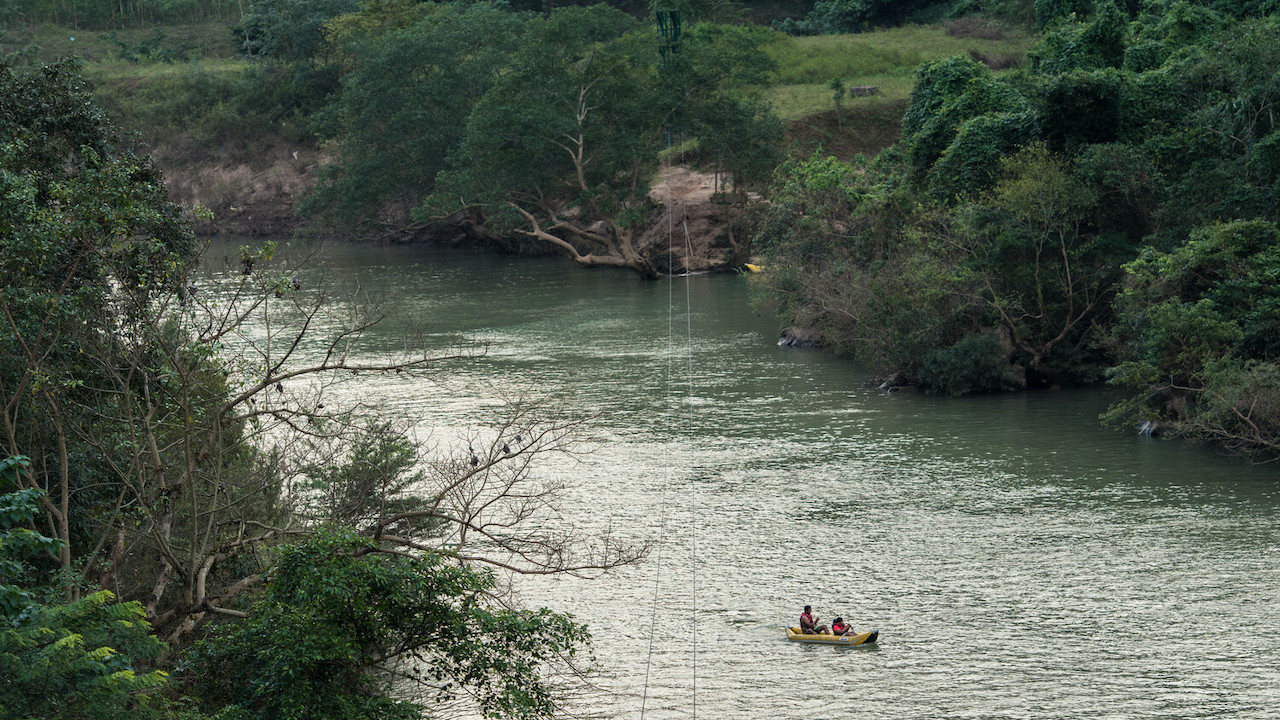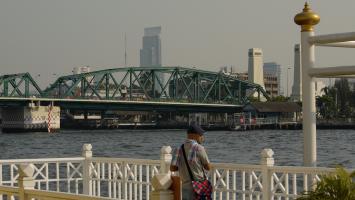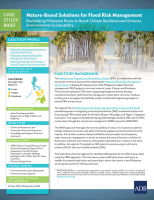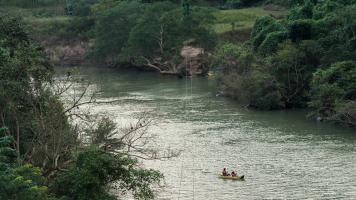
The Mekong, along with Chao Phraya, Citarum, and Hong are often cited as the most important rivers of Southeast Asia because of their significant geological features, biodiversity, and economic benefits. Photo credit: ADB.
Reversing alarming biodiversity losses in the region's most important rivers call for nature-based solutions, policy interventions, and innovative financing mechanisms.
Southeast Asia’s rivers are in crisis, with biodiversity losses already at alarming levels due to increasing pressure from population growth, rapid urbanization, industrialization, and climate change, a report from the Asian Development Bank (ADB) warns.
Focusing on the Mekong, Chao Phraya, Citarum, and Hong rivers, the report flags the effects of rapid urbanization, climate change, and industrialization on river basin pollution in the region where 110 million people lack access to safe water. These rivers are often cited as the most important rivers of Southeast Asia because of their significant geological features, biodiversity, and economic benefits.
The issue
In the Chao Phraya, water pollution is so bad that only an estimated 30 of 190 indigenous fish species can reproduce in the river mainstream, said the report. In the Citarum, heavy pollution has been associated with the loss of nearly 60% of the river’s species since 2008. Threats to biodiversity have been identified within the Sesan, Srepok, and Sekong rivers in the Lower Mekong Basin, the Tonle Sap Lake system, and the Mekong Delta, as dissolved oxygen levels in these areas have been in decline since 2000, and are at “polluted” and “very polluted” levels. Likewise, the rapid increase in heavy metal pollution in the Hong River Delta threatens the area’s biodiversity, the study said.
The rivers’ pollutants include municipal waste discarded by households, businesses, and institutions within urban areas, as well as from rural areas and informal settlements; industrial waste discharge, comprising of chemicals, heavy metals, and radioactive materials; agricultural waste from farms which discharge large quantities of agrochemicals, organic matter, drug residues, sediments, and saline drainage into water bodies; and plastic waste.
With the biodiversity loss having cascading environmental, social, and economic impacts, the report, Innovative Finance Approaches for Addressing River Basin Pollution: Combating Aquatic Biodiversity Loss in Southeast Asia, recommended ways to tackle river pollution and support sustainable development.
What’s at stake
Mekong River. Southeast Asia’s longest river is rich in biodiversity and is home to 1,200 fish species. It also boasts of ecological zones of national, regional, and global significance like wetlands. Flowing through Cambodia, Lao People’s Democratic Republic, Myanmar, Thailand, and Viet Nam, the river is economically important. The Lower Mekong Basin supports the lives and livelihoods of 52 million people. Key sectors supported include agriculture and the world’s largest inland fishery with an annual turnover of $1.4 billion–$3.9 billion.
Hong River. The Red River Delta’s coastal areas are home to a complex system of vegetation. In particular, the mangrove and intertidal habitats form wetlands of high biodiversity that also serve as globally important sites for migratory birds. The Hong, the largest river in Northern Viet Nam, supports a population of 26 million people, with a total agricultural area of nearly 1.09 million hectares.
Chao Phraya. Flowing through the heart of Thailand, including Bangkok, the river hosts about 280 fish species, including three of the largest freshwater fish in the world: the critically endangered giant barb, giant pangasius, and giant freshwater stingray. It is home to 57% of Thailand’s population. The basin area generates 66% of the country’s gross domestic product.
Citarum River. The river, which traverses Indonesia, is home to 160 plant species as well as a sizable number of mammals, birds, reptiles, and fish species that have been classified as threatened. About 5 million people live in the river basin.
The solution
The report said river pollution problem can be addressed by adopting nature-based solutions, policy measures, institutional arrangements, and innovative financing mechanisms.
Nature-based solutions. Nature-based solutions leverage on the intrinsic abilities of natural river systems to deliver resilience at a lower cost than traditional infrastructure development while minimizing negative environmental and social impacts. The approach is science-based and follows the principles of participatory water resources management. Solutions include planting mangroves, restoring wetlands, and building bioswales.
The study provided examples of how nature-based solutions could be deployed. It cited a study conducted at the mangrove forest site of the King’s Royally Initiated Laem Phak Bia Environmental Research and Development Project in Ban Laem District, Phetchaburi Province, Thailand, which demonstrated that mangrove forests can significantly improve water quality. The project increased dissolved oxygen levels by 32% and reduced levels of phosphate (by 88%), ammonia (by 74%), and nitrate (by 64%). This underscores mangrove effectiveness as an additional natural system to enhance the efficiency of manmade wastewater treatment systems.
The report also cited studies highlighting the strong potential of constructed wetlands for Southeast Asia. For example, an assessment of three full-scale constructed wetland systems across Thailand—the Koh Phi Phi, a world-renowned international tourist and holiday resort; Sakon Nakhon, a northeastern provincial capital; and Ban Pru Teaw, a small post-tsunami village on the Andaman Coast—showed nitrogen removal rates of 86% and biological demand reduction by 87%.
Policy measures. The report cited four economic incentive policy measures that could yield results in tackling river pollution in Southeast Asia: (i) payment for ecosystem services; (ii) water quality credit trading; (iii) water pollution taxes; and (iv) extended producer responsibility (EPR).
Payment for ecosystem services is a scheme requiring water supply, hydropower, and tourist companies to pay fixed rates to environmental services providers—which include state companies and villagers—as they conserve forests for watershed protection and landscape aesthetics.
Water quality credit trading is a market-based approach allowing entities to buy and sell pollution reduction credits.
Water pollution taxes are typically imposed on entities that discharge pollutants into water bodies such as rivers, lakes, and oceans. No jurisdiction in Southeast Asia has so far implemented water pollution taxes.
The extended producer responsibility scheme calls for the manufacturers and producers of goods to be responsible for managing the environmental impact of their products throughout the entire lifecycle. Indonesia, Thailand, and Viet Nam are among countries in Southeast Asia that have introduced an EPR system to fight plastic pollution.
Institutional arrangements. Institutional arrangements promote the practical implementation of these policies by coordinating government agencies, developing technical and administrative ability, engaging communities, and raising public awareness. Policy measures and institutional arrangements work in tandem to produce results. For example, having adequate institutional arrangements ensures the successful implementation of nature-based solutions, the proper execution of various legislative measures, and the effectiveness of employing innovative financing tools that facilitate the implementation of these solutions.
Financing mechanisms. Financing tools for addressing water pollution in the region are predominantly conventional, relying on government budgets, international aid, and traditional development loans. With the region facing huge infrastructure investment gaps, the report recommended the use of three innovative financing mechanisms: (i) blue bonds, (ii) public–private partnerships (PPPs), and (iii) blended finance. Deploying these financing mechanisms can potentially mobilize the resources needed to effectively tackle river water pollution.
A blue bond is a relatively new form of a sustainability bond. They are a type of debt instrument issued by governments, development banks, or others to raise capital from impact investors to finance marine- and ocean-based projects that have positive environmental, economic, and climate benefits.
Public–private partnerships are increasingly being implemented in diverse water subsectors in developing Asia. PPPs are commonly used in the water sector to develop, operate, and maintain various water infrastructure projects, including water distribution, wastewater treatment, and bulk water treatment and transmission. These partnerships involve collaboration between public authorities and private sector entities to deliver efficient, sustainable, and cost-effective water services.
Blended finance refers to the use of catalytic capital from public and philanthropic sources to increase private sector investment in sustainable development. Blended strategies seek to raise more money for investments in sustainable development in developing nations and can serve as a method to lower risk and boost lender confidence. Blended finance functions as a market-building instrument that creates a transition from dependence on grants and other donor finance toward commercial financing. It does so by deploying development finance in a way that addresses investment barriers that prevent commercial investment in Sustainable Development Goals-relevant sectors, such as water and sanitation.


